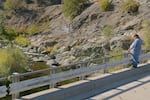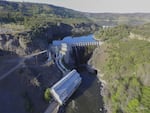Looking down at a pool filled with Klamath River salmon swimming back to their spawning grounds, Karuk Tribal Councilor Aaron “Troy” Hockaday says he can’t wait to see what the future holds for them.
“These fish right here give me hope,” he said. “They had a long journey from the mouth of the Klamath coming up here, so right now what they’re doing is resting a little bit.”
It’s a spot at the confluence of the Klamath and Scott rivers near the Northern California town of Yreka. Hockaday comes here often to check on the salmon that are vital to his people and their culture.
Right now, there aren’t many salmon for the Karuk and other area tribes to catch. That’s because hundreds of miles of salmon spawning habitat are blocked by four dams on the lower Klamath River.
But an historic decision made on Thursday in Washington, D.C. holds the promise to change that. The Federal Energy Regulatory Commission’s approval of removing those four dams should set free a huge stretch of one of the West’s most important coastal rivers for salmon and reopen 400 miles of habitat — much of which salmon have been unable to reach for more than a century.
“It’s gonna be one of the best things for our fish and our fisheries,” Hockaday said. “It’s been a long, long journey to get to where we are today.”

Karuk Tribal Council member Aaron "Troy" Hockaday watches salmon swimming upstream near the confluence of the Klamath River and the Scott River tributary on Oct. 13, 2022.
Brandon Swanson / OPB
Next year, deconstruction work will begin at JC Boyle, Copco 1, Copco 2 and Iron Gate dams, with the biggest dams scheduled to be removed in 2024.
Getting to this point has taken decades of negotiation and planning, and removing the four dams will be a massive, $500 million undertaking that many in the surrounding communities still oppose.
Pros and cons of dam removal
The Klamath River drains an arid basin that straddles two states. It flows from Upper Klamath Lake in the high desert of south-central Oregon, crosses the California state line, and empties into the Pacific Ocean. Tearing down four of its dams won’t just open up habitat to boost salmon populations. Supporters say a more free-flowing river will also improve water quality by removing the dam’s reservoirs where warm water pools, collects pollution from agricultural runoff and invites toxic algae growth and bacteria that can cause fish die-offs.
But in the drought-stricken Klamath River Basin, anything connected to water is controversial — including dam removal. Opponents argue those reservoirs are vital to surrounding communities because they provide tax revenue, recreation opportunities and waterfront property values that will be lost when the dams are taken out.
Residents in both of the counties surrounding the dams slated for removal have voted overwhelmingly over the past decade in favor of keeping the dams in place because of the benefits they offer and the potential for dam removal to create problems with flooding and the release of sediment stored behind the dams.
After first trying to relicense the dams in the early 2000s, PacifiCorp agreed to remove them in 2016 to avoid the cost of building fish ladders that would have been required to help salmon swim upstream.
PacifiCorp spokesman Bob Gravely said removing the dams at a cost of $215 million to the utility’s ratepayers was actually the cheaper option, and the electricity they generate is easily replaced — it’s less than 2% of the utility’s supply.

Iron Gate Dam is about 200 miles from the ocean on the Klamath River in Northern California. It is one of four dams slated for removal by the end of 2024.
Michael Wier / Courtesy of the Klamath River Renewal Corporation
Gravely said dam removal alone will not put more water in the river, and it won’t alleviate the painful water shortages that have worsened with drought over the last several years.
Contested decisions over water distribution in the past 20 years have jeopardized the survival of protected fish and wildlife and the livelihoods of local farmers and ranchers.
This year, irrigation water for farmers and ranchers in the Klamath Basin was cut off to protect threatened and endangered species of sucker fish in Klamath Lake and salmon in the Klamath River.
But dam removal isn’t likely to help with any of that.
“Dams don’t actually take water from the river,” Gravely said. “One of the problems on the Klamath is there’s just lots of demands for a certain amount of water, and those disputes will continue after dam removal. There’s going to be the same water supply at the end of the day.”
Water conflicts spurred dam removal talks
In 2001, thousands of people in Klamath Falls formed a symbolic “bucket brigade” to protest a government decision to cut off irrigation water to farmers in the Klamath Basin.
The mile-long line of people passing buckets of water to a dry irrigation canal and the ensuing effort to pry open the canal gates were followed by a Bush administration decision to send more water to farmers the next year. Many later blamed the administration for causing a devastating fish kill in 2002 that left thousands of dead salmon floating in the lower Klamath River.
It was around that time that PacifiCorp needed to renew the licenses for its four Klamath River dams and that renewal required the company to comply with environmental regulations like adding fish passage that didn’t exist when the dams were built.
“These were very high-profile events, and a lot of stakeholders actually used the relicensing of the Klamath dams as a forum to have a discussion of these broader issues,” Gravely said. “And so that is really when the idea of dam removal was put on the table.”

A $500 million plan to remove four dams owned by PacifiCorp will allow the Klamath River in Southern Oregon and Northern California to flow freely for hundreds of miles to the ocean, Aug. 24, 2022.
Brandon Swanson / OPB
Dam removal became part of a lengthy set of negotiations among irrigators, tribes and environmental groups over how to resolve the water problems in the Klamath River Basin. In 2010 the parties arrived at the Klamath Basin Restoration Agreement, a hard-won compromise that promised land to the Klamath Tribes, environmental protection for fish and some guaranteed water for agriculture.
Two additional settlement agreements detailed plans to remove the four dams and address water issues in the Upper Klamath Basin. Together, the three agreements represented a decade of negotiations, and they required federal funding from Congress that never came.
After the original agreements expired, the parties changed the dam removal agreement so that it alone could be approved by FERC instead of relying on Congress.
But the water supply guarantees for farmers and ranchers are now missing from the plans, along with the promise of land for the Klamath Tribes. Support for dam removal fractured along with the agreements themselves.
Opponents worry about property values, taxes, sediment
Opponents of dam removal say they’re worried farmers might have to give up irrigation water to flush out the sediment stored behind the dams. And they’ve expressed doubts that dam removal will be all that beneficial for salmon, considering that scientists can’t guarantee the salmon won’t be harmed by all the sediment flowing downriver after the dams come out.
“This is seen in many respects as a grand experiment. We’re gonna try it and see if it works,” said Brandon Criss, board of supervisors chairman in Siskiyou County, which is home to three of the four dams slated for removal. “Our concern is it won’t. And then if it doesn’t work we have all the problems, but none of the solutions, and we’re left holding the bag.”
He says the dams benefit surrounding communities by providing tax revenue, jobs, recreation and lakefront property on the reservoirs. And all of that will be lost when the dams are removed.
About 300 people who live around Copco Lake, the reservoir above Copco 1 Dam, have already seen their property values drop in anticipation of the lake disappearing with dam removal.
Earlier this year, the Siskiyou County Board of Supervisors sent a letter to California Gov. Gavin Newsome outlining the costs of dam removal to the county and its residents. They listed new flood risks, impacts to water wells, lower property values and property tax losses among their concerns. The board asked the state to put an additional $50 million into a mitigation fund and to direct $25 million in funding to the county to cover its losses.

Next year, deconstruction work will begin at JC Boyle Dam in Southern Oregon and Copco 1, Copco 2 and Iron Gate dams in Northern California with the biggest dams scheduled to be removed in 2024.
Courtesy of the Klamath River Renewal Corporation
“We’re limited on revenue in a rural county,” Criss said. “Our libraries are already volunteer. Fire departments are already volunteer. We need that tax revenue to keep deputies on the street to keep people safe.”
Desiree Tullos, a professor of river engineering and restoration at Oregon State University, is part of a research team with the Yurok Tribe that is working to understand how the river changes after dam removal and what kinds of management actions will be needed to improve water quality for fish, wildlife and people.
Tullos said proposals to tear out dams often prompt concerns about the impacts of sediment and the potential for flooding, but these problems rarely materialize. Her research also looks at how water quality changes after dam removal affect people, their understanding of the river system and their trust in each other.
“The Klamath is a really great place to study dams as agents of change,” she said. “Science has generally ignored the human response to dam removal. This is a major change in the basin that has the potential to really benefit folks in terms of bringing people together, and we want to document that.”
Tribes kept pushing for dam removal
After the 2002 fish kill, tribes in the basin blamed the Bush administration for sending more water to farmers at the expense of the fish.
And they ramped up their fight for dam removal.
Frankie Myers sits on the Yurok Tribal Council in Northern California. He remembers the early days of discussion about dam removal. Dam opponents were gaining hope, but then a Federal Energy Regulatory Commission meeting made it clear that the lower Klamath dams had a good chance of being relicensed, keeping them in place for decades to come.
A small group of tribal members headed to a gravel bar in the Klamath River afterward to sit around a fire to talk about their disappointment.
“We thought we’re going to be watching the decline of our river for another 50 years. And it brought to the forefront that we needed to dramatically shift what we were doing and start asking for dam removal,” Myers said. “And then it kind of spread this fire.”

Members of various tribes in the Klamath River Basin traveled to Scotland in 2004 to call for dam removal at a shareholders meeting of Scottish Power, owner of PacifiCorp at the time.
Courtesy of the Karuk Tribe
Tribal members from all over the Klamath Basin traveled across the country and even as far as Scotland to attend shareholder meetings of PacifiCorp’s parent company at the time, Scottish Power, to call for the dams’ removal.
Klamath Tribal Chairman Clayton Dumont said his homeland in Southern Oregon is ready to welcome back salmon for the first time in more than a century. But those salmon will face the water quality problems in Klamath Lake that are harming declining sucker fish populations.
“We haven’t seen salmon in our territory since my great-grandfather was fishing,” he said. “We’re overjoyed, of course, that the dams are finally going to come out. … But at the same time, we’re worried about the impaired ecology up here and hoping we can get things in a state that will allow them to not just survive here but thrive.”
Myers said the Yurok people have been through terrible times on the Klamath River over thousands of years, and that’s how they know it’s worth fighting to bring the salmon back.
“Salmon are the keystone species that enables the Klamath Basin to survive,” he said. “We know that if we fight and we live and work to restore our landscapes that they will return again because we’ve seen it happen. And I think that’s what drives us so passionately toward dam removal because we know what salmon can do.”
Deconstruction starts next year

The 126-foot Copco 1 Dam was built in 1916 and is scheduled for removal in the summer of 2024.
Michael Wier / Courtesy of the Klamath River Renewal Corporation
With the FERC decision on Thursday, an elaborate dam removal plan kicks into gear.
PacifiCorp’s dam licenses will transfer to the newly formed nonprofit Klamath River Renewal Corporation, along with the states of Oregon and California, which kicked in $280 million to help pay for the dam removal project.
The company will assume the responsibility for and liability of dam removal. That includes temporary management of all the properties connected to the dams and, after they’re gone, the restoration of habitat.
PacifiCorp will also transfer management of two upriver dams, Keno and Link, to the Bureau of Reclamation. They will remain in place but will need to have fish ladders installed so salmon can swim around them.
The dam removal plan includes a lot of construction work to prepare the dam’s reservoirs for drawdown. That early work will start next spring. The reservoirs will be drained beginning in early January of 2024 and the three largest dams, JC Boyle, Copco 1 and Iron Gate, will be removed that summer.
On Thursday, as federal regulators met to give their final approval for dam removal, Myers returned to the same gravel bar on the Klamath River where his fight for dam removal began.
Together with members of the Yurok, Karuk and Hoopa Valley tribes, he lit a fire and watched the Federal Energy Regulatory Commission meeting via satellite link.
“Almost 20 years later, we have this half-billion-dollar project to remove the four lower dams and be a part of the largest salmon restoration project ever conducted,” Myers said. “It’s pretty exciting.”
Myers said there’s still a lot of work to be done to restore the Klamath Basin beyond removing the dams.
“But if we don’t remove the dams, nothing else really matters after that,” he said. “I want to feel good. I want to feel really, really happy. But I am forcing myself to stay focused. When the heavy equipment rolls, and we start hauling dirt, ask me that day how I feel.”
